
We have now experienced 25 years of significant drought in the southwestern United States and northwestern Mexico. In the Colorado River basin (Figure 1), the annual flow of the Colorado River has decreased by approximately 19% in the 21st century compared to the 20th century.
From 1906 to 2000, the Colorado River basin averaged about 14.6 million acre-feet (MAF) annually. In the 21st century, average annual flows on the Colorado River have averaged approximately 12.5 MAF per year. This represents a decrease of about 1.75 MAF per year, which is approximately 19% less than the 20th-century average (https://www.congress.gov/crs-product/R45546).
This decline is attributed to the change in the climate with warming temperatures and reduced precipitation and is being referred to as a megadrought. The megadrought in the southwestern United States, beginning in 2000, is currently the driest multi-decade period in the region since at least 800 CE. This megadrought has been the driest in at least 1,200 years, exceeding a similar megadrought in the late 1500s. (Woodhouse, et al. 2010).
Long range climate models predict further reductions in Colorado River stream flows, with some projections showing declines of 5% to 30% compared to the 1971-2000 average by 2050 (Colorado Climate Center, 2023).
As a result, reservoirs are low throughout the region and the stress on water delivery systems is extreme. Recent projections by the U.S. Bureau of Reclamation indicate a high probability of water levels at Lake Mead in December 2026 to be lower than 1,050 ft. above sea level (Figure 2), which would trigger Tier 2a reductions based on the 2007 interim guidelines, Minute 323, lower basin drought contingency plan, and the binational water scarcity contingency plan (Figure 3).
However, all these conservation guidelines on the Colorado River will expire in 2026. Therefore, there is still the need for the delegations representing the Colorado River basin states to develop an agreement on a new set of conservation guidelines. At present, the lower basin states are in agreement, but the upper basin states will not accept the terms proposed by the lower basin states. Thus, they remain at an impasse.
Based on the Law of the River (The Law of the River: Foundational Documents and Programs, CRS, 2025), if the basin states are not able to decide on a new plan together, the U.S. Department of the Interior (DoI) and the Bureau of Reclamation (BoR) will have the responsibility for making the decisions.
At present, a new commissioner for the BoR has not been appointed by the new federal administration. However, based on my understanding from recent basin state meetings, the BoR has been more engaged under the Trump administration and that should be helpful. Stong leadership on these issues is urgently needed, and the situation is presenting a serious test on our system of governance on the Colorado River.
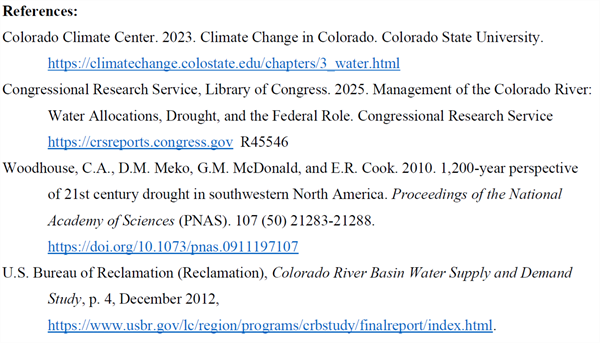
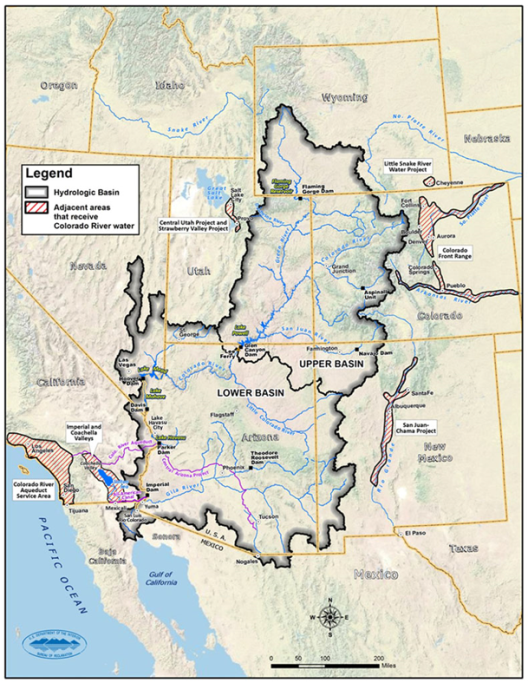
Figure 1. The Colorado River basin and U.S. areas that import Colorado River water.
Source: Bureau of Reclamation, Colorado River Basin Water Supply and Demand Study,
2012.
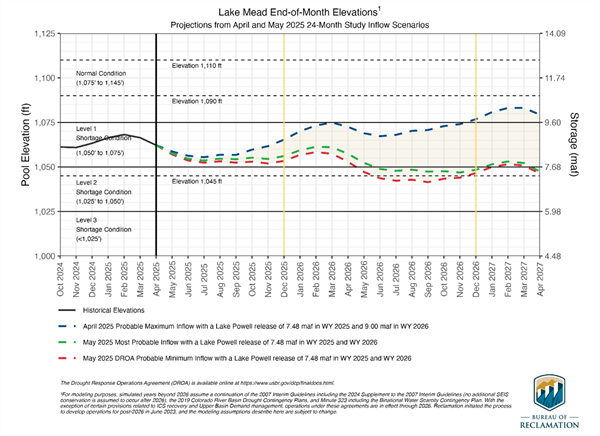
Figure 2. Lake Mead end-of-month elevations based on model projections from April and
May 2025, 24-Month study inflow scenarios.
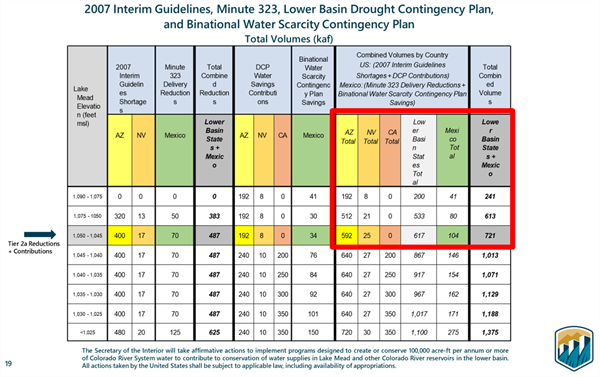
Figure 3. Tier 2a reductions based on the 2007 interim guidelines, Minute 323, lower
basin drought contingency plan, and binational water scarcity contingency plan.
Source: U.S. Bureau of Reclamation.
I sent this out early this year, but I am resending the information as we have had few calls about the disease in desert southwest. Looks like we traded downy mildew for botrytis this year..
Botrytis rot is not considered a major problem in lettuce, but it can cause significant damage/loss when the field conditions are favorable for the pathogen. Cool wet conditions are favorable for the pathogen. Symptoms include water-soaked, brownish-gray to brownish-orange, soft wet rot that occurs on the oldest leaves in contact with the soil. Old leaves are more susceptible than young leaves and the fungus
can move into the healthy parts. Fuzzy gray growth can be observed in the disease area which is characteristic of the pathogen. In worse cases, the entire plant can collapse. Romaine cultivars, transplanted lettuce that are big and have leaves touching the soil are more susceptible.
The pathogen: Botrytis cinerea
Botrytis cinerea affects most vegetable and fruit crops, as well as a large number of shrubs, trees, flowers, and weeds. Outdoors Botrytis overwinters in the soil as mycelium on plant debris, and as black, hard, flat or irregular sclerotia in the soil and plant debris, or mixed with seed. The fungus is spread by anything that moves soil or plant debris, or transports sclerotia. The fungus requires free moisture (wet surfaces) for germination, and cool 60 to 77 F, damp weather with little wind for optimal infection, growth, sporulation, and spore release. Botrytis is also active at low temperatures, and can cause problems on vegetables stored for weeks or months at temperatures ranging from 32 to 50. Infection rarely occurs at temperatures above 77 F. Once infection occurs, the fungus grows over a range of 32 to 96 F.
Masses of microscopic conidia (asexual spores) are produced on the surface of colonized tissues in tiny grape-like clusters (see picture). They are carried by humid air currents, splashing water, tools, and clothing, to healthy plants where they initiate new infections. Conidia usually do not penetrate living tissue directly, but rather infect through wounds, or by first colonizing dead tissues (old flower petals, dying foliage, etc.) then growing into the living parts of the plant.
Disease management:

There are more than 50 broadleaf and grass weeds in this area that are common and have been here for a long time. It would be great to have an herbicide that will control all of them, be safe to the crop and be gone the next day after harvest.
Obviously, we are a long way from achieving this. What we have done instead is select for the weeds that escape our weed control practices. Anything that shifts the advantage to the crop instead of the weeds will help. Our practices include the use of herbicides, mechanical techniques and hand hoeing. Good weed control can be achieved using all three but may not be economical.
Weed selection due to herbicide availability was evident a few years ago when leaf lettuce was removed from the Kerb label in 2009. It is well known that Kerb, Prefar and Balan were the standard herbicides used in lettuce for the last 60years. Kerb will control the grasses and most of the broadleaves consistently including many that are not controlled by the other two products such as shepherds purse, london rocket and wild mustard. The longer that Kerb was unavailable the more prevalent some weeds would become. On January 12, 2016, the EPA label for Kerb was reinstated for leaf lettuce bringing back the tool to the industry1.
Prefar will control grass consistently, purslane and pigweed most of the time, lambs quarters and goosefoot some of the time. Balan will control grass consistently and many of the small-seeded broadleaves some of the time.
The postemergence grass herbicides were registered about 30 years ago but for broadleaf weeds there has not been a new registration in half a century.

Reference:
1. Retrieved from the www on Oct 14, 2024 https://ucanr.edu/blogs/blogcore/postdetail.cfm?postnum=21270#:~:text=On%20January%2012%2C%202016%20the%20Federal%20EPA,55%20day%20prior%20to%20harvest%20(Table%201).
2. https://cales.arizona.edu/crop/vegetables/advisories/more/weed122.html
I had the privilege of knowing John for just over a year, yet his impact on my professional journey has been profound. To me, John was more than a colleague—he was a mentor. The knowledge I acquired from him will shape my career for years to come. His legacy was truly contagious and has inspired me to follow in his footsteps. John’s influence will continue to guide and motivate me throughout my life.
May God bless your soul, John. Rest in peace.Lettuce is one of the most important vegetable crops in the Yuma, Arizona region. However, growing healthy lettuce in the desert isn’t easy. High temperatures, salty soils, and very low rainfall (less than 3 inches per year) make crop management especially difficult. Growers are always looking for better tools to improve crop growth while saving water and reducing input costs.
Biostimulants are one such tool. These are natural products often made from seaweed extracts, organic acids, or beneficial microbes that are added to the soil or irrigation water. They don’t replace fertilizers, but they can help plants grow better by improving how roots absorb nutrients and handle stress like heat, drought, or poor soil quality.
Our Trial in Yuma, AZ
To better understand whether biostimulants can help desert lettuce crops, we conducted a field trial during the 2024–2025 growing season at the University of Arizona’s Valley
Research Center in Yuma. The field was managed using subsurface drip irrigation, a water-saving system that delivers moisture directly to the plant roots below the soil surface. We tested a commercially available biostimulant made from organic compounds and micronutrients known to support root and shoot growth.
The trial included several treatments, some with biostimulant and some without, under both traditional and sensor-based irrigation scheduling. We tracked plant height every two weeks to monitor lettuce growth and compared results between the treated and untreated plots.
What We Found
In the organic lettuce trial, biostimulant use did not result in a clear or measurable increase in plant height. All treatments (Figure 1), whether biostimulant was applied or not, showed similar growth patterns and reached comparable final heights by the end of the season. In the conventional lettuce trial, the tallest plants appeared in the biostimulant-treated plots; however, the difference compared to untreated plots was small and not statistically significant. When the data from both systems were combined, conventional treatments consistently produced taller plants than organic ones, regardless of biostimulant application. These findings suggest that biostimulant effects on plant height are minimal and highly dependent on the production system and environmental or management factors.
Takeaway
Biostimulants may not be a magic solution for crop growth and development, but they offer promise as part of an integrated crop management strategy. In desert systems where water is limited and soils can be harsh, even modest improvements in plant growth can help growers increase their productivity and resilience.
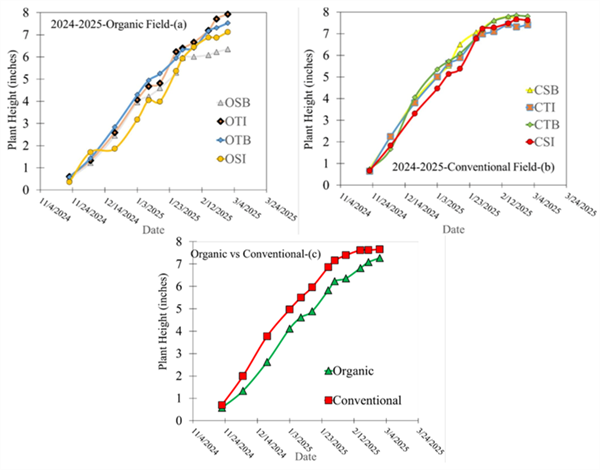
Figure 1. Distribution of plant height: (a) Organic Field; Organic sensor-based irrigation +
biostimulant (OSB), Organic traditional-based irrigation (OTI), Organic traditional-based
irrigation + biostimulant (OTB), and Organic sensor-based irrigation (OSI); (b)
Conventional Field; Conventional sensor-based irrigation + biostimulant (CSB),
Conventional traditional-based irrigation (CTI), Conventional traditional-based irrigation +
biostimulant (CTB), and Conventional sensor-based irrigation (CSI); (c) Pooled data for
Organic and Conventional Field treatments. Each data point represents the average of
10 readings collected in the field at the Valley Research Center, University of Arizona,
Yuma Agricultural Center, Yuma, Arizona.
This time of year, John would often highlight Lepidopteran pests in the field and remind us of the importance of rotating insecticide modes of action. With worm pressure present in local crops, it’s a good time to revisit resistance management practices and ensure we’re protecting the effectiveness of these tools for seasons to come. For detailed guidelines, see Insecticide Resistance Management for Beet Armyworm, Cabbage Looper, and Diamondback Moth in Desert Produce Crops .
VegIPM Update Vol. 16, Num. 20
Oct. 1, 2025
Results of pheromone and sticky trap catches below!!
Corn earworm: CEW moth counts declined across all traps from last collection; average for this time of year.
Beet armyworm: BAW moth increased over the last two weeks; below average for this early produce season.
Cabbage looper: Cabbage looper counts increased in the last two collections; below average for mid-late September.
Diamondback moth: a few DBM moths were caught in the traps; consistent with previous years.
Whitefly: Adult movement decreased in most locations over the last two weeks, about average for this time of year.
Thrips: Thrips adult activity increased over the last two collections, typical for late September.
Aphids: Aphid movement absent so far; anticipate activity to pick up when winds begin blowing from N-NW.
Leafminers: Adult activity increased over the last two weeks, about average for this time of year.







